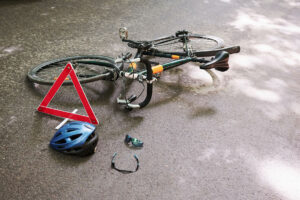As an active cyclist, your safety is paramount. Grasping the common causes of bicycle accidents equips you with the knowledge to better avoid them. This article aims to delve into those often-overlooked dangers on the road, from cyclists’ own errors to motorists’ behavior, and even environmental factors. By understanding these risks, you’ll be better prepared to navigate the roadways. Let’s take the first pedal stroke on this enlightening journey into bicycle safety.
Understanding the Factors Contributing to Bicycle Accidents
Accidents involving bicycles can often be attributed to a myriad of factors. Each one paints a unique picture of what could go wrong in what would otherwise be a routine ride. As a cyclist, understanding these broad factors is your first step in ensuring your safety.
One key factor is the cyclist’s own behavior. According to a study by the National Highway Traffic Safety Administration (NHTSA), cyclist error was a factor in about 13% of bicycle accidents in 2020. This could range from misjudging traffic conditions, failing to adhere to road rules, to executing risky maneuvers without full situational awareness. Training and experience can significantly reduce the incidence of these errors.
Next, the behavior of motorists comes into sharp focus. The same NHTSA study reveals that motorist error accounted for 35% of bicycle accidents. This includes errors like failing to yield right-of-way to cyclists, not noticing cyclists on the road, or even driving at inappropriate speeds in areas frequented by cyclists. Remember, as a cyclist, you are sharing the road with vehicles that could be potential hazards.
Finally, environmental conditions play a significant role in bicycle accidents. A study by the Royal Society for the Prevention of Accidents found that factors such as poor road conditions, bad weather, and low-visibility conditions like nighttime cycling or blind corners were responsible for a substantial number of accidents. These are conditions often outside your control, but being aware of them can help you make better decisions while on the saddle.
In essence, the cycling ecosystem is complex and fraught with potential dangers. As a cyclist, recognizing these factors — your behavior, motorists’ actions, and the environment — is pivotal in taking the necessary precautions. The road might seem like a daunting place, but with a proper understanding of these risks, you can ride confidently and safely.
Cyclist Behavior: A Pivotal Factor in Bicycle Accidents
When discussing bicycle accidents, the behavior of the cyclist is often an essential component. The way you conduct yourself on the road has a direct impact on your safety. Recognizing common cyclist errors can help mitigate these risks.
A common issue, highlighted in a study by the National Highway Traffic Safety Administration, is improper signaling. Cyclists often neglect to indicate their intentions on the road — a habit that accounted for about 7% of all cycling accidents in the year 2020. You may be intending to make a turn, but if other road users are not aware of your intentions, collisions become a real possibility.
Equally significant is the failure to adhere to road regulations. Many cyclists occasionally ride against traffic, don’t stop at stop signs, or don’t use a light at night. According to a report by the Pedestrian and Bicycle Information Center, failure to obey traffic laws was a contributing factor in approximately 17% of cyclist fatalities in 2019. Pennsylvania laws apply to all users on the road, including cyclists, and disregarding them can lead to grave consequences.
Risk-taking behaviors, such as weaving through traffic or ignoring traffic signals, are other key contributors to accidents. A 2018 study by the Journal of Safety Research found that high-risk maneuvers were involved in 10% of cyclist accident hospital admissions. While it may save a few minutes, the risk isn’t worth your safety.
Impairment is another critical aspect of cyclist behavior leading to accidents. Alcohol or drug influence, as well as fatigue, can impair a cyclist’s reaction times and judgment. The Insurance Institute for Highway Safety (IIHS) found that in 2020, 21% of fatally injured cyclists had a blood alcohol concentration at or above 0.08 percent.
As a cyclist, your actions on the road significantly influence your safety. By understanding the potential consequences of poor signaling, non-adherence to traffic laws, risky behaviors, and riding while impaired, you can make better decisions and reduce the likelihood of an accident. Your behavior is one of the few factors you can directly control, so use this control wisely.
Motorist Behavior: A Major Contributor to Bicycle Accidents

A key issue is drivers failing to notice cyclists on the road. According to a 2020 report from the National Highway Traffic Safety Administration (NHTSA), about 40% of bicycle accidents occurred due to a motorist not seeing the cyclist. This underscores the importance of making yourself visible when cycling, particularly in low-light conditions.
Another common motorist error is the failure to yield the right-of-way. The NHTSA study found that nearly 30% of cyclist accidents involved a motorist not yielding to a cyclist at an intersection or when making a turn. As a cyclist, even if you have the right-of-way, it’s crucial to approach intersections with extra caution.
Speeding or inappropriate speeds, particularly in areas where cyclists are present, are also significant contributing factors. The AAA Foundation for Traffic Safety found in 2019 that speed-related crashes accounted for a quarter of cyclist fatalities. As a cyclist, be particularly cautious when cycling near high-speed roads.
Motorist impairment, due to alcohol, drugs, or distraction, also plays a significant role in bicycle accidents. The Centers for Disease Control and Prevention (CDC) reported that in 2020, 28% of drivers involved in fatal accidents with cyclists were impaired. While you can’t control the actions of drivers, being aware of signs of impairment can help you respond more effectively.
Remember, as a cyclist, you must be prepared for the unexpected. Understanding how driver behavior can lead to accidents empowers you to be more vigilant and responsive. Sharing the road with motorists can be safe, but it requires a high level of awareness and precaution.
The Role of Environmental Conditions in Bicycle Accidents
As a cyclist, you’re not just contending with traffic; you’re also navigating the physical environment. Factors such as road conditions, weather, and visibility can have a profound impact on your safety on the road. Let’s shed some light on how these environmental conditions can contribute to accidents.
Firstly, poor road conditions are a significant hazard. Potholes, debris, or irregular surfaces can cause a cyclist to lose control. A study published by the American Journal of Public Health in 2020 found that around 17% of bicycle accidents are due to poor road infrastructure or maintenance. As a cyclist, always keep a close eye on the road ahead and report hazardous conditions to local authorities whenever possible.
Inclement weather is another factor that can increase the risk of an accident. Wet, icy, or windy conditions can drastically affect your control and braking distance. A 2018 report from the Royal Society for the Prevention of Accidents (RoSPA) stated that weather conditions contributed to approximately 8% of cyclist injuries. Always consider the weather forecast before you set out on a ride, and adjust your riding style in response to the conditions.
Finally, low-visibility conditions, such as cycling at night or around blind corners, can make it difficult for motorists to see you. The Insurance Institute for Highway Safety (IIHS) reported that about 50% of bicycle deaths in 2020 occurred between 6 pm and 6 am. To mitigate these risks, ensure you have appropriate lighting on your bike and reflective gear on your person.
Understanding how the environment can influence the likelihood of an accident is key to safer cycling. By being aware of road conditions, adapting to weather changes, and enhancing your visibility in low-light conditions, you can significantly decrease your risk of being involved in an accident. The environment may be beyond your control, but how you respond to it isn’t.
Bicycle and Equipment Issues: An Overlooked Cause of Accidents
Your bicycle and the equipment you use can greatly influence your safety. As a cyclist, paying attention to their condition can prevent unnecessary accidents. Let’s explore how these factors play a part in cycling mishaps.
Mechanical failures can lead to accidents, with brakes being the primary concern. In a 2019 study by the National Highway Traffic Safety Administration (NHTSA), brake failures contributed to around 7% of reported cycling accidents. Regular maintenance is crucial to ensure your brakes are always in good working order.
Another equipment issue is tire punctures or blowouts. A sudden loss of tire pressure can cause a loss of control, potentially resulting in an accident. According to the same NHTSA study, tire-related issues were the cause of about 5% of cycling accidents. Checking tire pressure and overall tire condition before each ride can help you avoid such incidents.
The role of safety equipment, particularly helmets and visibility gear, is also significant. The Insurance Institute for Highway Safety reported in 2020 that only about half of cyclists who died in accidents were wearing helmets. Properly fitted helmets can significantly reduce the risk of serious head injuries. Meanwhile, a lack of visibility gear, such as reflectors and lights, can make it difficult for motorists to see cyclists, increasing the risk of accidents.
Cycling, as rewarding as it is, comes with inherent risks. As you navigate the roads, understanding the common causes of bicycle accidents is crucial in safeguarding your journey. Your behavior, motorist actions, environmental conditions, and the state of your bicycle all intertwine to shape your safety profile. By acknowledging these factors and acting proactively, you hold the power to drastically decrease your risk of accidents. A well-informed cyclist is a safer cyclist.
If you get into a bicycle accident in Allentown, we’re here to help. Contact an Allentown bicycle accident lawyer at Munley Law today to schedule a free consultation.
Munley Law Personal Injury Attorneys
609 Hamilton St
Allentown, PA 18101
(610) 857-7424









